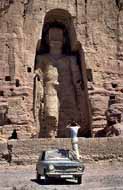|
Afghanistan: In the Rubble, Hope for the Future

|
 |
The world community was aghast when the hardline Taliban regime in Kabul dynamited Afghanistan's colossal eighth-century Bamiyan statues, committing a "crime against culture," in the words of UNESCO Director-General Koïchiro Matsuura. UNESCO had been in the forefront of desperate efforts to prevent the atrocious act, seeking joint action with the Organisation of the Islamic Conference and pleading with Taliban officials, but to no avail. Raheen Makhdoom, Afghanistan's Information and Culture Minister, said: "Perhaps, should there have been international recognition of the Monuments and Sites of the Bamiyan Valley as World Heritage, the Taliban forces and the terrorist supporters may have thought twice before deliberately destroying the Buddhas, now lost forever." |
|
The regime-sponsored vandalism was a new clarion call
underscoring the fragility of our precious shared heritage, whether
or not it is inscribed on the prestigious World Heritage List. Francesco
Bandarin, Director of UNESCO's World Heritage Centre, said that the
tragedy prompted "discussions on the actual ability of the international
community to ensure the protection of heritage threatened by conflicts."
Regrettably, the family of nations had little recourse in a case such
as the Bamiyan Buddhas, especially since the Taliban were not the
recognised legitimate government in Afghanistan. "There are international
tools, but they cannot prevent wilfull destruction," Bandarin
said, noting that barely more than 100 countries are signatories to
the 1954 Convention for the Protection of Cultural Property in the
Event of Armed Conflict, also known as the Hague Convention. The treaty,
which renounces the destruction, pillage or dangerous use of cultural
heritage, is administered by UNESCO, which has wielded its moral authority
or provided logistical and expert assistance in reducing or repairing
damage caused by conflicts. |
 |
 |
|

|
 |
A Second Protocol to the Hague Convention which was adopted in 1999, but has yet to take effect, contains far-reaching new measures that would make it the first international instrument to explicitly define crimes against cultural property. The new protocol criminalises the destruction of specified cultural property. Individuals will face responsibility for such acts, and can be extradited. The new text also strengthens obligations for international cooperation in protecting cultural properties and prosecuting those guilty of violations.
For now, a "light in the darkness," Bandarin says, is the indictment in 2001 by the International Criminal Tribunal for the Former Yugoslavia of Serb commanders accused of carrying out the bombing of Dubrovnik in 1991. They face charges including "destruction or willful damage to historic monuments and institutions dedicated to religion", a violation of the laws or customs of war under the tribunal's statute. The indictment notes that during the shelling of Dubrovnik, "the Old Town area was specifically targeted. … The Old Town of Dubrovnik was a UNESCO World Cultural Heritage Site in its entirety. A number of the buildings in the Old Town and the towers on the city walls were marked with the symbols mandated by the (1954) Hague Convention."
The Dubrovnik indictment "shows a new attitude of international courts towards sanctioning willful destruction," Bandarin said.
|
Back |
 |





